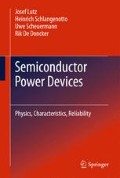Abstract
Most power diodes are pin-diodes, i.e. they possess a middle region with a much lower doping concentration than the outer p- and n-layers enclosing it. Compared with unipolar devices (see Chap. 6), pin-diodes have the advantage that the on-resistance is strongly reduced by high-level injection in the base region, which is known as conductivity modulation . Hence pin-diodes can be used up to very high blocking voltages. The base region is not intrinsic, as suggested by the name. The intrinsic case – doping in the range of < 1010 cm−3 – would not only be difficult to attain by technology, extremely low doping would cause essential disadvantages in the turn-off behavior and other properties. Power diodes usually have a p+n−n+-structure, hence the so-called i-layer is actually an n−-layer. Since it is several orders of magnitude lower than the doping of the outer layers, the name pin-diode has become the usual denotation in almost every case
Access this chapter
Tax calculation will be finalised at checkout
Purchases are for personal use only
References
Baburske R, Heinze B, Lutz J, Niedernostheide FJ: “Charge-carrier Plasma Dynamics during the Reverse-recovery Period in p+-n--n+ diodes, IEEE Trans. Electron Devices ED-55 No 8, pp. 2164–2172 (2008)
Baliga BJ, Modern Power Devices, John Wiley & Sons, New York 1987
Baliga BJ: “Power Devices” in S.M. Sze: Modern Semiconductor Device Physics, John Wiley & Sons, New York 1998
Bartsch W, Thomas B, Mitlehner H, Bloecher B, Gediga S: “SiC-Powerdiodes: Design and performance” Proceedings European Conference on Power Electronics and Applications EPE, (2007)
Benda HJ, Spenke E: “Reverse Recovery Process in Silicon Power Rectifiers”, Proceedings of the IEEE, Vol 55 No 8 (1967)
Chen M, Lutz J, Domeij M, Felsl HP, Schulze, HJ: “A novel diode structure with Controlled Injection of Backside Holes (CIBH)”. Proceedings of the ISPSD, Neaples pp. 9–12 (2006)
Cooper RN: “An investigation of recombination in Gold-doped pin rectifiers”, Solid-St. Electron. 26, 217–226 (1983)
Deboy G et al: “Absolute measurement of carrier concentration and temperature gradients in power semiconductor devices by internal IR-Laser deflection”, Microelectronic Engineering 31, 299–307 (1996)
Drücke D, Silber D: “Power Diodes with Active Control of Emitter Efficiency”, Proceedings of the ISPSD, Osaka, pp. 231–234 (2001)
Drücke D: Neue Emitterkonzepte für Hochspannungsschalter und deren Anwendung in der Leistungselektronik, Dissertation, Bremen 2003
Felsl HP, Falck E, Pfaffenlehner M, Lutz J: “The Influence of Bulk Parameters on the Switching Behavior of FWDs for Traction Application”, Proceedings Miel 2004, Niš/Serbia & Montenegro, 2004
Felsl HP, Pfaffenlehner M, Schulze H, Biermann J, Gutt T,. Schulze HJ, Chen M, Lutz J: “The CIBH Diode – Great Improvement for Ruggedness and Softness of High Voltage Diodes” ISPSD 2008, Orlando, Florida, pp. 173–176 (2008)
Hall RN, “Power rectifiers and transistors”, Proc IRE 40, 1512–1518 (1952)
Huang Q: “MOS-Controlled Diode - A New Class of Fast Switching Low Loss Power Diode” VPEC, pp. 97–105 (1994)
Huang Q, Amaratunga GAJ: “MOS Controlled Diodes - A new Power Diode” Solid-St. Electron. 38 No 5, 977–980 (1995)
IXYS data sheet FMD 21-05QC (2000)
Kopta A, Rahimo M: “The Field Charge Extraction (FCE) Diode – A Novel Technology for Soft Recovery High Voltage Diodes” Proc. ISPSD Santa Barbara, pp. 83–86 (2005)
Laska T, Lorenz L, Mauder A: “The Field Stop IGBT Concept with an Optimized Diode”, Proceedings of the 41th PCIM, Nürnberg (2000)
Lutz J, Scheuermann U: “Advantages of the New Controlled Axial Lifetime Diode”, Proceedings oft the 28th PCIM, Nuremberg (1994)
Lutz J, Wintrich A: “The Hybrid Diode - Mode of Operation and Application”, European Power Electronics and Drives Journal Vol. 10 No. 2 (2000)
Lutz J, Mauder A: “Aktuelle Entwicklungen bei Silizium-Leistungs-dioden”, ETG-Fachbericht 88, VDE-Verlag Berlin (2002)
Mourick P, Das Abschaltverhalten von Leistungsdioden, Dissertation, Berlin 1988
Nemoto M et al: “Great Improvement in IGBT Turn-On Characteristics with Trench Oxide PiN Schottky Diode”, Proceedings of the ISPSD, Osaka (2001)
Schlangenotto H, Gerlach W: “On the effective carrier lifetime in psn-rectifiers at high injection levels”, Solid-St. Electron. 12, pp. 267–275 (1969)
Schlangenotto H, Maeder H: “Spatial Composition and Injection Dependence of Recombination in Silicon Power Device Structures”, IEEE Trans. Electron Devices Ed-26, No 3, pp. 191–200 (1979)
Schlangenotto H, Silber D, Zeyfang R: “Halbleiter-Leistungsbauelemente - Untersuchungen zur Physik und Technologie”, Wiss. Ber. AEG-Telefunken 55 Nr. 1–2 (1982)
Schlangenotto H et al, “Improved Recovery of Fast Power Diodes with Self-Adjusting p Emitter Efficiency”, IEEE Electron Dev. Letters Vol. 10. pp. 322 – 324 (1989)
Shimada Y, Kato K, Ikeda S, Yoshida H: “Low input capacitance and low loss VD-MOSFET rectifier element”, IEEE Trans. Electron Devices, Volume 29, Issue 8, pp. 1332–1334 (1982)
Silber D, Novak WD, Wondrak W, Thomas B, Berg H: “Improved Dynamic Properties of GTO-Thyristors and Diodes by Proton Implantation”, IEDM, Washington (1985)
Advanced tcad manual. Synopsys Inc. Mountain View, CA. Available: http://www.synopsys.com (2007)
Sze SM, Physics of Semiconductor Devices. John Wiley & Sons, New York 1981
Wolley ED, Bevaqua SF: “High Speed, Soft Recovery Epitaxial Diodes for Power Inverter Circuits”, IEEE IAS Meeting Digest (1981)
Wondrak W, Boos A, “Helium Implantation for Lifetime Control in Silicon Power Devices,” Proc. of ESSDERC 87, Bologna, pp. 649–652, (1987)
Author information
Authors and Affiliations
Corresponding author
Rights and permissions
Copyright information
© 2010 Springer-Verlag Berlin Heidelberg
About this chapter
Cite this chapter
Lutz, J., Schlangenotto, H., Scheuermann, U., De Doncker, R. (2010). pin-Diodes. In: Semiconductor Power Devices. Springer, Berlin, Heidelberg. https://doi.org/10.1007/978-3-642-11125-9_5
Download citation
DOI: https://doi.org/10.1007/978-3-642-11125-9_5
Published:
Publisher Name: Springer, Berlin, Heidelberg
Print ISBN: 978-3-642-11124-2
Online ISBN: 978-3-642-11125-9
eBook Packages: EngineeringEngineering (R0)

